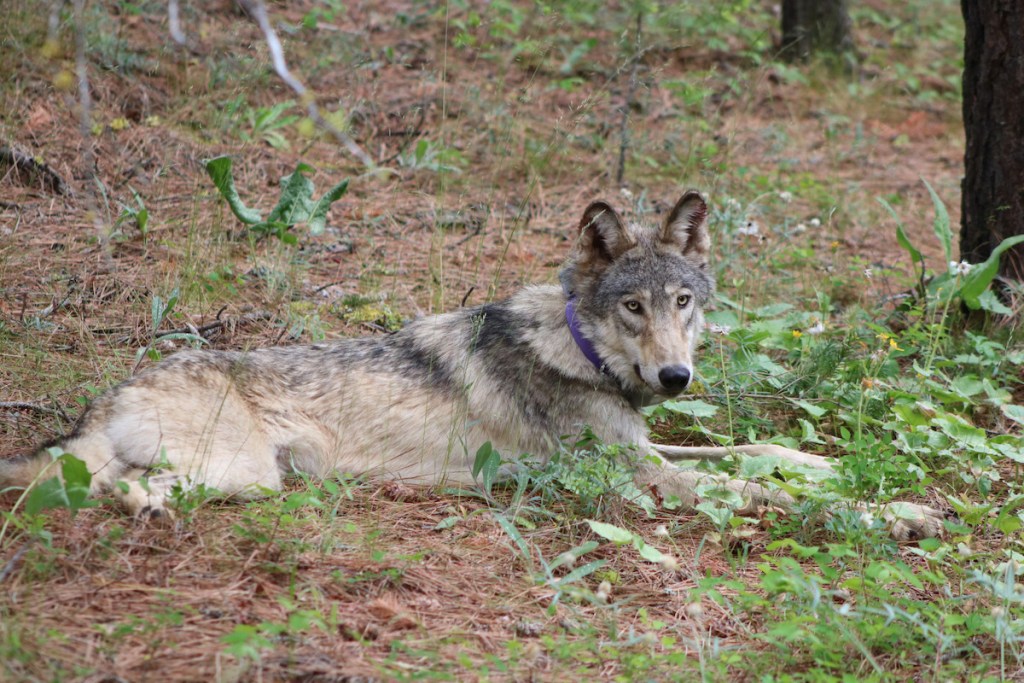A young male gray wolf who broke from his Oregon pack in search of new territory and a mate has made his way all the way to California’s Central Coast, marking the first time in more than a century that the species has been detected here.
In an epic journey that took around two months, the wolf ― known as OR-93 and fitted with a radio collar ― traveled 600 long miles and crossed at least two busy highways to reach San Luis Obispo County on April 6.
Experts say if OR-93 continues his southeast trajectory through the Los Padres National Forest, he could enter Santa Barbara County in a matter of days.
“It’s really exciting,” said Jeff Kuyper, director of Los Padres ForestWatch, a wilderness protection organization. “We certainly hope he stays safe out there.” Track OR-93’s progress here.
California’s gray wolf population was wiped out in the early 1900s during a nationwide eradication effort led by the livestock industry. In the 2000s, a handful made their way from Canada back into Washington and Oregon, and in 2011, OR-7 was the first to cross California’s border. OR-93 is the 17th wolf known to have entered the state since then.
According to the California Department of Fish and Wildlife, fewer than a dozen wolves currently live in California. That includes the Lassen pack, which consists of five wolves, a new pair spotted late last year in Siskiyou County, and now OR-93. The Shasta pack and its seven members disappeared within months of its discovery in 2015. Scientists feared poaching.
OR-93 was born two years ago southeast of Mt. Hood as part of the White River Pack, according to research done by Los Padres ForestWatch. He was fitted with a tracking collar by federal biologists and the Confederated Tribes of Warm Springs. Like many young wolves, he eventually split from the group to stake his own claim.
The Los Padres would provide a good permanent range and lots of food sources for OR-93, Kuyper said. In 2016, Fish & Wildlife scientists identified it as one of the California regions that would be a suitable habitat for the species. “But the big question is he going to stick around and keep foraging?” Kuyper asked, “or is he going to return from whence he came?”
The other big question is the matter of a mate. With no evidence of any female wolves in the area, “He may be looking for love in all the wrong places,” Kuyper said. But it’s not impossible that a northern wolf could pick up OR-93’s scent and follow him south, he explained.
Wolves, Kuyper stressed, pose very little safety risk to humans, and he pointed to several steps landowners can take to reduce the risk of livestock loss, including fladry, range riders, night penning, and foxlights. For safety and research purposes, Fish & Wildlife asks anyone who spots a wolf to report it here.
Evidence suggests gray wolves were once endemic to Santa Barbara County. A forest ranger reported seeing one in 1910 in the Upper Santa Ynez watershed, according to ForestWatch, and another was later spotted at a lemon ranch in Montecito. The Chumash have their own word for wolf (miy), which is distinct from their terms for coyote (xoxau) and dog (tsun).
While biologists have believed for some time that wolves would eventually repopulate California, no one expected to see one this far south this soon. “If you had asked a scientist if they thought there would be a wolf in Central California in 2021, they would have scoffed,” Kuyper said. Around the state, the slow but steady reintroduction of elk ― a favorite prey item ― could entice the lasting residency of future packs, Kuyper said. Solitary wolves typically hunt small prey and scavenge bigger animals.
Gray wolves are protected as an endangered species under state law, making it illegal to harass, hurt, or kill them. Violations are thoroughly investigated and penalties are stiff ― a $100,000 fine and possible prison time. “If you see something that looks like a really big coyote with a purple collar on,” Kuyper said, “don’t shoot at it, or there will be consequences.”
Support the Santa Barbara Independent through a long-term or a single contribution.

